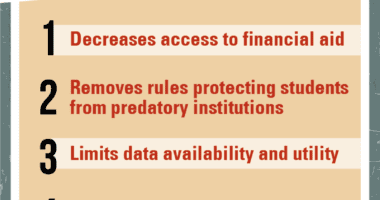Letter From The Education Trust to Senator Lamar Alexander Regarding Higher Education Accountability White Paper
The Honorable Lamar Alexander
Chairman
Senate Committee on Health, Education, Labor and Pensions
Washington, DC 20510
Dear Senator Alexander,
On behalf of The Education Trust, an organization dedicated to closing long-standing gaps in opportunity and achievement that separate low-income students and students of color from their peers, thank you for the opportunity to comment on your recently released white paper concerning accountability in higher education.
The research is clear: A college degree is the surest path to upward social mobility, particularly in our economy, with two-thirds of new jobs requiring some form of postsecondary education. Yet, there are glaring — and growing — gaps in who enters and completes college.
Since the original Higher Education Act (HEA) was passed in 1965, the U.S. has made substantial progress in college access. College-going rates have climbed for students from all economic and racial groups. Yet despite this progress, low-income students are just now enrolling in postsecondary education at rates their high-income peers did in the mid-1970s.i And the low-income students and students of color who do enroll in college are far less likely than other students to enroll in institutions where most students graduate and far more likely to enroll in the institutions that graduate few of their students and create disproportionate debt.ii Indeed, in every category of postsecondary education, low-income students and students of color are less likely than others to earn the degrees that they want and need, and far more likely to end up with debt and no degree.
As Congress moves forward with reauthorizing the Higher Education Act (HEA), we are pleased you are focused on accountability and ensuring that every dollar the federal government invests in higher education is used effectively, efficiently, and in the best interest of the increasingly diverse public.
However, the white paper made the argument that higher education accountability should be based exclusively on measures of loan repayment. We believe this approach is woefully inadequate. Higher education accountability should be more nuanced, more differentiated, and more focused on the measures on which institutions have the most control.
A reauthorized HEA must build upon the existing accountability structures.
Accountability provisions currently in place, including the 90/10 and gainful employment requirements — which aim to cap federal funding of for-profit colleges and hold career training programs accountable for providing labor market return on investment among graduates — represent important safeguards against the proliferation of unscrupulous institutions of higher education and low-quality postsecondary credentials.iii History has shown that, given the chance, many institutions will take advantage of the availability of federal grants and loans, leaving students worse off than when they started — with debt but no degree, or with a credential that has no market value. These existing accountability provisions must be maintained and strengthened.
And while these existing rules are critical, they need to be augmented with a system that creates pressure and support for the entire higher education system to improve, especially for the low-income students and students of color who are most likely to be underserved by today’s system.
Accountability in a reauthorized HEA must include measures of access and completion.
Research shows that the strongest predictor of loan default is whether a student completes college.iv Thus, any federal efforts to improve higher education must go beyond issues of cost and focus on improving completion. But we have also seenv that existing state completion-focused policies that use financial incentives to hold campuses more responsible for student outcomes have been shown to push schools to become more selectivevi and keep out those students — typically low-income students and students of color — who are perceived as more “risky.” There needs to be a simultaneous focus on increasing completion and ensuring that schools serve the students for whom higher education can offer the most benefit.
Instead of a blunt, one-size-fits-all accountability system that relies on a single metric, as the white paper proposes, lawmakers should adopt a system that helps poorly performing institutions improve, holds them accountable when they fail to do so, pushes selective institutions to enroll more low-income students, and rewards institutions that enroll and graduate large shares of Pell-eligible students.
A higher education accountability framework that promotes racial and socioeconomic equity must:
- Establish minimum standards for institutions on enrolling historically underserved students and for improving student performance and outcomes on measures such as retention, transfer, graduation and job placement, especially for these student groups;
- Sustain and increase investments in low-resource campuses to support the implementation of evidence-based strategies that improve completion especially for historically underserved students;
- Provide rewards for institutions making continual growth toward reaching ambitious access and success goals within a reasonable timeline; and
- Enforce meaningful consequences for underperforming institutions that, after getting needed resources, time and support, fail to meet minimum enrollment and performance standards.
All metrics must be disaggregated and equity prioritized.
Before disaggregation of data was required in our K-12 system, we knew anecdotally that schools were not educating all groups of students well. But we did not know just how significant the inequities were, and we didn’t know which schools were making progress and which weren’t. Unfortunately, we are largely in the same place now in higher education.
As with the K-12 system, if we look only at overall averages, we sweep the opportunity gaps that exist for low-income students, students of color, and other vulnerable populations under the rug. An accountability system that does not pay attention to these inequities is insufficient. During the process of reauthorizing the Elementary and Secondary Education Act, Congress agreed that the opportunities and outcomes for different groups of students had to matter. We believe that same agreement must continue in reauthorizing HEA.
Again, we appreciate the attention to accountability in higher education and believe there is opportunity in this next reauthorization to build an equity-focused system. We also appreciate the attention to loan repayment as an important metric. However, the white paper does not present a comprehensive approach to re-envisioning how to support racial and socioeconomic equity and educational excellence for all that our higher education system so desperately needs.
Sincerely,

John B. King Jr.
President and CEO
The Education Trust
cc: Sen. Patty Murray, Ranking Member
i U.S. Department of Education, National Center for Education Statistics (2016). Digest of Education Statistics 2015.
ii Ed Trust analysis of IPEDS Fall enrollment, Fall 2014 (by race) and NCES National Postsecondary Student Aid Study (NPSAS:12),
2011-12 (by Pell recipient status).
iii https://www.brookings.edu/blog/brown-center-chalkboard/2017/01/11/how-much-do-for-profit-colleges-rely-on-federal-funds/;
Comparison of for profits and community college repayment and outcomes, https://ticas.org/blog/three-ways-scorecard-data-show-difference-between-profit-and-community-colleges; For
profits students earn less than they did prior to enrolling (negative return on investment),
http://www.nber.org/papers/w22287; Loan repayment rates by sector,
https://trends.collegeboard.org/sites/default/files/2017-trends-student-aid_0.pdf
iv https://files.eric.ed.gov/fulltext/EJ905712.pdf
v https://tcf.org/content/report/why-performance-based-college-funding-doesnt-work/
vi https://jhupbooks.press.jhu.edu/content/performance-funding-higher-education



